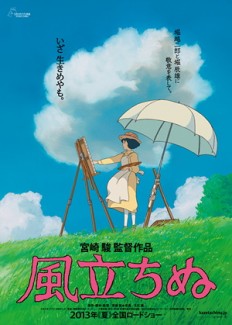The Wind Rises (Kaze Tachinu) (Hayao Miyazaki, 2013): Japan
Reviewed by Daniel Chein. Viewed at SBIFF.
I love Hayao Miyazaki. Growing up on films like My Neighbor Totoro (1988) and Kiki’s Delivery Service (1989), I have a soft spot for anything Miyazaki brings to the screen. As the director and screenwriter of dozens of animated films, he has a wildly imaginative vision, an incredible sensibility for storytelling, and a stubborn insistence on preserving the traditional aesthetic of hand-drawn animation. That is what gives his film that look, feeling, and ability to seamlessly transport his audience from the 3rd dimension into the 2nd. Some time ago Miyazaki announced that this would be his final feature animation,* so when I saw that The Wind Rises would be playing in a theater in Japanese at the Santa Barbara International Film Festival, I nearly lost my marbles.
Loosely based on the short story The Wind Has Risen by Tatsuo Hori, The Wind Rises is a historical fantasy set in pre-WWII Japan about a promising young engineer named Jiro Horikoshi who dreams of designing airplanes. As a boy, Jiro has lucid dreams about flying airplanes and befriends Caproni, an Italian aeronautical pioneer, in them. Because Jiro is extremely near-sighted, he has his doubts about ever becoming a pilot, but Caproni reassures him that his impairment will not inhibit him from designing planes, his true passion. Upon waking up from his dreams, Jiro is inspired and works diligently to make his dreams come true. As a young adult, having excelled in school, he leaves home to study engineering at a university in Tokyo. On the train, he meets a young girl in Naoko with whom he shares a moment of serendipity. As the train is speeding down the tracks, wind catches Jiro’s hat and sends it flying. Naoko, on the next train down, snags the hat out of the air, nearly loosing her footing and falling off the train. As fate would have it, this single event would be the beginning of something special between Jiro and Naoko.
For those who have seen other Miyazaki films, The Wind Rises is somewhat of an oddity, as the story-world is absent of magicians, flying castles, or cat-buses. But the fact that The Wind Rises is unique in this sense makes it significant in terms of Miyazaki’s life and body of work. In this piece, he looks into his past for inspiration, as many people, places, and events are actually based on actuality, giving the film an added depth of realism that is often mixed in with the supernatural in his other films. Though the story may be simplistic, it offers human and historical insight into Japanese culture, behavior, and opinions. For example, Jiro’s work ethic reflects that of many Japanese, and because Germany had superior aviation technology at the time, many German things were considered better than Japanese things, like cigarettes. Ultimately, I think the essence of The Film Rises is its conveyance of the Japanese “way,” as modernity, samurai ethics, and ephemeral love come together in this remarkable story and piece of art.
*For Miyazaki fanatics like me: great news! Hayao recently announced on Japanese radio that he will not be retiring after all! More here.
About this entry
You’re currently reading “The Wind Rises (Kaze Tachinu) (Hayao Miyazaki, 2013): Japan,” an entry on Student Film Reviews
- Published:
- 02.04.14 / 11pm
- Category:
- Animation, Films, Santa Barbara Film Festival 2014

3 Comments
Jump to comment form | comments rss [?] | trackback uri [?]